Key takeaways:
- Flood management requires balancing stakeholder perspectives, embracing both technical solutions and community concerns.
- Active involvement of stakeholders fosters ownership, accountability, and trust, enhancing community engagement in flood resilience initiatives.
- Effective communication techniques, such as active listening and storytelling, significantly improve dialogue and understanding among diverse participants.
- Flexibility and engagement strategies during discussions create opportunities for richer exchanges and continued dialogue post-conference.
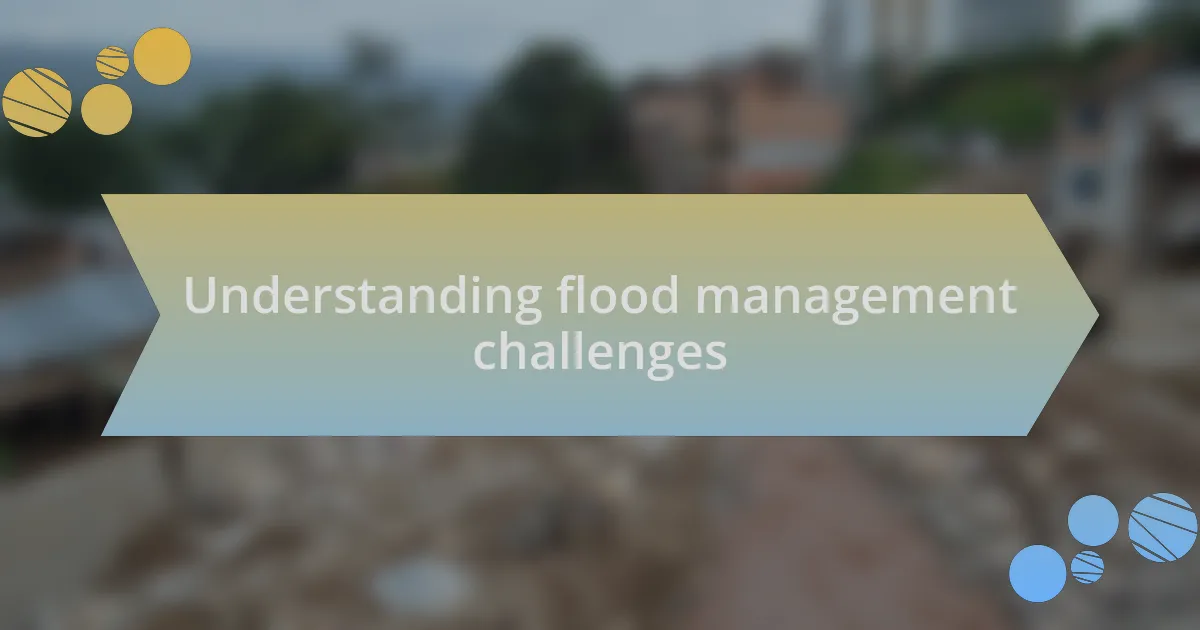
Understanding flood management challenges
Flood management challenges can feel overwhelming at times. I remember attending a local town hall meeting after a devastating flood. Residents were frustrated; some had lost everything, while others felt helpless as they watched their homes succumb to rising waters. It made me realize that flood management isn’t just about technical solutions—it’s deeply personal.
One major hurdle is the need to balance the diverse perspectives of stakeholders. On one hand, we have engineers pushing for infrastructure solutions, while on the other, community members often prioritize environmental restoration. How do we create a unified approach that addresses both concerns? From my experience, it often requires open dialogue and a willingness to listen—something I’ve seen work wonders in bridging gaps and fostering collaboration.
Additionally, the unpredictability of weather patterns due to climate change adds another layer of complexity. I’ve spoken to farmers who’ve struggled to adapt their practices as floods become more frequent. It’s a stark reminder that effective flood management must incorporate adaptive strategies that acknowledge not just current realities but also future uncertainties. The challenge lies in ensuring preparedness without spiraling into fear. I find it crucial to foster a hopeful mindset while tackling these serious issues.
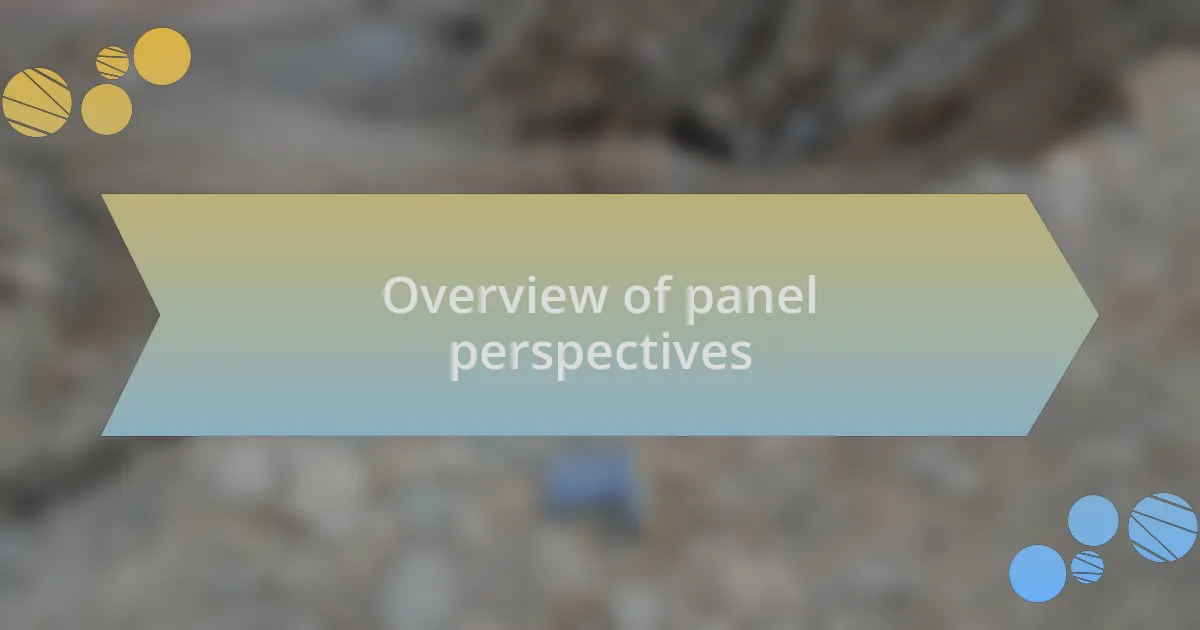
Overview of panel perspectives
Panel perspectives in flood management are incredibly varied and deeply rooted in personal experiences. During one conference, I listened to a passionate environmentalist share a story about how his childhood home was swallowed by a flood. He described not just the physical loss, but the emotional impact on his family and community. It struck me that these perspectives are not just intersecting arguments; they are snippets of real lives intertwined with broader ecological questions.
I’ve noticed that engineers often focus on concrete solutions, which can sometimes come across as detached from the emotional realities at play. For instance, one engineer recounted the challenge of designing barriers to combat rising waters while still respecting the land’s natural flow. It made me wonder—how do we balance innovation with empathy? Each panelist carries their own narrative, and in those stories, we find the raw emotions that fuel their passion for flood management.
Ultimately, these differing perspectives create a rich tapestry of dialogue, blending logic with lived experiences. It’s essential to create a space where every voice finds its resonance, whether through the lens of scientific data or the heartfelt tales of those affected. I’ve learned that engaging with these diverse viewpoints not only deepens our understanding but also ignites a genuine commitment to collective action.

Importance of stakeholder involvement
Stakeholder involvement is crucial in flood management because it fosters a sense of ownership and accountability among the community. When I participated in a local flood resilience workshop, I witnessed firsthand how engaged residents shared their lived experiences. Their insights led to actionable plans that were not only effective but also embraced by everyone involved.
Moreover, including diverse perspectives can bridge gaps between technical solutions and community needs. I recall a discussion where local farmers expressed concern over engineered flood defenses that interfered with irrigation. This conversation highlighted the importance of hearing their voices and adapting strategies accordingly. Isn’t it interesting how often the solutions lie with those who have practical, on-the-ground knowledge?
Finally, when stakeholders feel that their input is valued, it builds trust and collaboration. During a panel I attended, a community leader shared the impact of feeling excluded from decision-making processes. His emotional appeal underscored how vital it is to actively involve all relevant parties. Engaging stakeholders isn’t just a checkbox; it’s about creating lasting relationships that strengthen our collective response to floods.

Strategies for balancing views
Finding common ground among diverse views requires intentional strategies that foster dialogue. For instance, in a workshop I attended on flood resilience, breaking participants into small groups enabled everyone to express their concerns in a safe space. It was eye-opening to see how much more willing people were to share when they felt heard by their peers, leading to solutions that incorporated various perspectives.
Another effective strategy is establishing ground rules for discussions to ensure respectful communication. I recall a panel I was part of where we agreed that each speaker would have equal time to share their thoughts without interruption. This approach created an atmosphere of respect and encouraged more nuanced conversations, allowing us to tackle conflicting views without the chaos of one-sided debates. Have you ever noticed how a lack of structure can stifle meaningful discourse?
Lastly, utilizing visual aids can clarify complex viewpoints while engaging participants. During a community meeting, we used charts and maps to illustrate flood risks alongside proposed interventions. This not only made the data more accessible but also invited feedback from individuals who might have otherwise remained silent. I find that visuals can spark curiosity and dialogue, helping to balance views in a truly collaborative way.
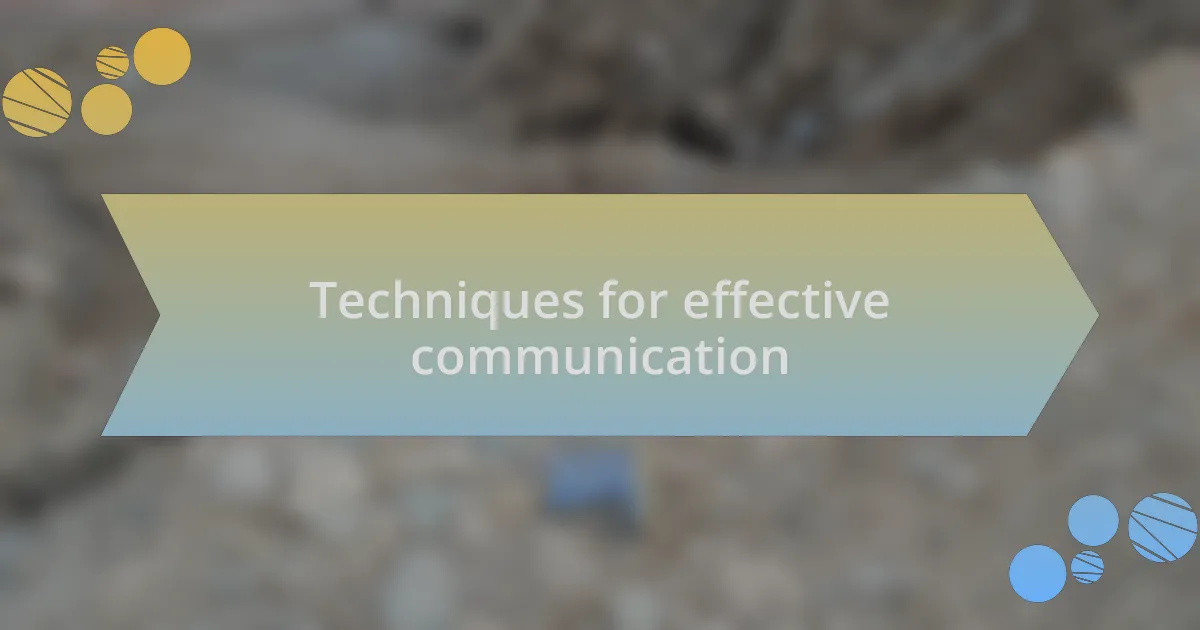
Techniques for effective communication
One effective technique for fostering communication is encouraging active listening. I remember a session where a facilitator asked us to summarize what the previous speaker had said before we shared our own thoughts. It felt oddly refreshing to ensure each voice resonated through the room. This practice not only validated our peers but also deepened our understanding of differing perspectives. Have you ever experienced that ‘aha’ moment when you truly grasp someone else’s viewpoint?
Integrating storytelling into discussions can also be powerful. At a flood management conference, I witnessed a speaker who shared a personal story about losing their home to flooding. The emotional weight of their experience transformed the room; suddenly, the conversation shifted from abstract data to real human impact. This technique not only captivates an audience but also invites empathy, prompting participants to consider solutions that address people’s lived realities. Isn’t it fascinating how a single story can bridge gaps between holders of diverse perspectives?
Moreover, utilizing breakout discussions can enhance participation. I facilitated a roundtable where small groups developed key takeaways before sharing them with the larger audience. This approach consistently yields dynamic conversations, as individuals feel empowered to express their ideas without the pressure of a big audience. Have you considered how this might transform the way voices are shared in your own discussions?
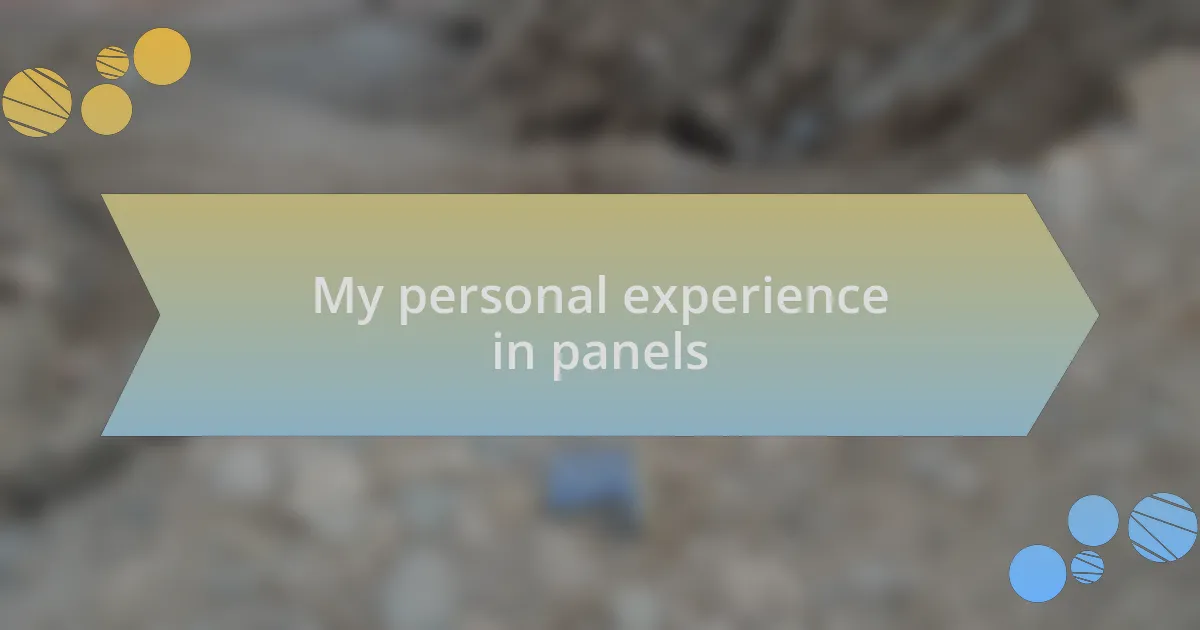
My personal experience in panels
In my journey through various panels, I’ve often found myself sitting in a chaotic mixture of voices. During one session, I was struck by how differing opinions could create a charged atmosphere. I recall a heated debate about flood mitigation strategies, where my insights clashed with those of a seasoned expert. It was uncomfortable yet exhilarating to navigate that tension. Have you ever found yourself in a similar situation, where the clash of ideas propelled a deeper understanding?
Another memorable experience involved working alongside a diverse group of panelists, each bringing unique backgrounds to the discussion. I remember a colleague who had recently transitioned from a frontline disaster response role. Their fresh perspective added a new layer to our conversation, reminding me of the real-world stakes involved in our dialogue. This experience reaffirmed my belief that varying panel perspectives not only enhance discussions but also deepen our collective commitment to solving complex challenges. How often do you consider the value that different backgrounds bring to a conversation?
In my experience, embracing vulnerability in panel settings has proven transformative. During one of my most challenging sessions, I admitted my own struggles in grappling with the data presented. Surprisingly, that openness allowed others to share their vulnerabilities, too. The shift in energy was palpable; suddenly, we weren’t just experts or attendees; we were a community united by common hurdles. Have you noticed how transparency can break down barriers and foster connection in discussions?
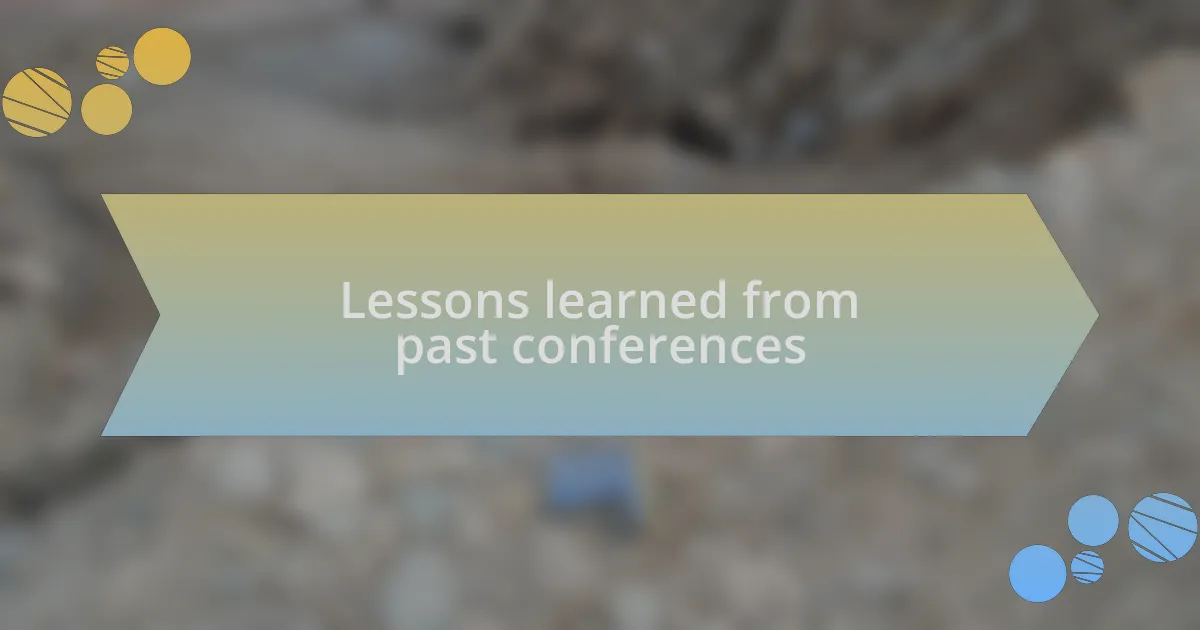
Lessons learned from past conferences
In reflecting on past conferences, I’ve learned that preparation is key, but flexibility is equally vital. I remember one particular event where last-minute changes in the agenda led to some unexpected yet profound discussions. The initial panic quickly morphed into an opportunity when panelists adapted their contributions, leading to richer exchanges that might not have occurred otherwise. Isn’t it fascinating how spontaneity can ignite deeper conversations?
Another important lesson I’ve drawn from my experiences is the significance of engagement strategies. I recall a session where facilitators used interactive approaches, like real-time polls and breakout groups. This not only drew out quieter voices but also fostered a sense of ownership among participants. Have you ever noticed how even small adjustments in format can dramatically change the dynamic of a discussion?
Lastly, it has become clear to me that post-conference follow-ups are indispensable for deepening understanding. In one instance, our team revisited discussions through a series of webinars, allowing panelists to elaborate on their thoughts and to connect with attendees on a deeper level than we could during the live sessions. This approach made me realize that the conversation doesn’t end when the conference does; it merely evolves. What do you think makes follow-ups effective in maintaining the momentum of these dialogues?